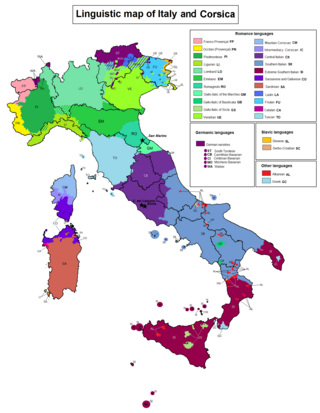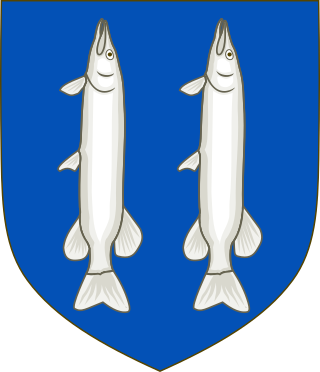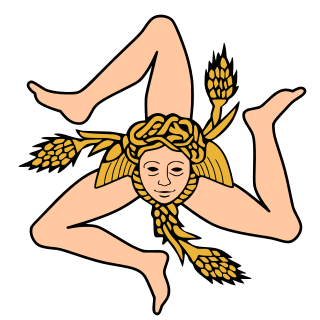
Asmundo is an old Sicilian noble family that has played a notable role in the island's political, cultural, and economic history.

Asmundo is an old Sicilian noble family that has played a notable role in the island's political, cultural, and economic history.
The ancient origins of the Asmundo family are muddled in legends. According to some sources, originating from Pisa, also known as Sismondo or Sismondi since the time of Charlemagne, the family would have arrived in Sicily at the time of the Norman conquest by Count Roger. [1] [2] In this case, they would be connected with the Pisan Sismondi family, mentioned by Dante Alighieri in the Divine Comedy , which included Sigismondo, who became Prior of the Republic of Pisa in 774, and the legendary heroine Kinzica de' Sismondi. Others think they originated from Malta and moved to Sicily at the time of the Sicilian Vespers. [3] Their lineage may be descended from the Asmunds, kings of Sweden before the year 1000. [4]
Members of various branches of the Asmundo family occupied important administrative positions in the Kingdom of Sicily, ever since the time of the Aragonese. Adamo Asmundo, doctor in civil law at the University of Padua, was rationum magister (master of finances) at the Court of Royal Property and luogotenente generale . In 1432 he took part in the special Royal Council that governed the island during the absence of King Alfonso V, who was on his expedition to Djerba. In the same year he became President of the Realm with viceregal functions until 1435, a position that he would again attain in 1439 and 1449, under King Alfonso.

The Asmundo family possessed many titles and fiefdoms, including the castellan domains of Aci, Taormina, and Mazzara, and the fiefs of Jace, Baldirone, Pontalica, Callura, Missanèllo, Lamia, Targia, Xirumi, Troina, Capici, Militello, Alcara, Salomone, Ameda, Salandra, San Giuliano, Campopetro, Villasmundo, San Dimitri, Gisira, and Scalarancio. The wealth and privilege of the Asmundos allowed them to play important roles in the political and cultural history of Sicily.
In 1434, Adamo Asmundo, along with Battista Platamone, founded the University of Catania, one of the oldest still extant universities in the world. Among the first lecturers in theology appointed by Viceroy Lope Ximénez de Urrea y de Bardaixi in 1445 was the Carmelite Nicola Asmundo, a graduate of the University of Bologna. [5]
Bartolomeo Asmundo, a senator of Catania from 1492 to 1532, was a reformer of studies at the city's university from 1495 to 1497. He is considered the first lyric poet of Sicily and one of the greatest poets in the Sicilian language. [6] His fame is connected with some canzoni on sacred and profane themes inspired by Petrarchism, translated from Sicilian into Italian by Pietro Bembo (1470–1547). His achievements include characterizing the canzuna as a major poetic form as distinct from the sonnet, and promoting Sicilian as a sublime language of poetry. [7]
Following the 1693 Sicily earthquake that devastated Catania and the Val di Noto, Giuseppe Asmundo was a leader in the urban and cultural rebirth in the affected areas. In Catania, among other works, he rebuilt the orphan girls' school Conservatorio delle Verginelle, [8] and contributed, through the prior Bartolomeo Asmundo, to the construction of the church of the Immacolata Concezione ai Minoritelli. In Noto, he was the commissioner general for reconstruction. [9] Together with Giuseppe Lanza (vicar general for the Val di Noto), Giovanni Montalto, Sipione Coppola, and the Jesuit architect Angelo Italia, he was one of the architects of the form of renaissance that took the name Sicilian Baroque. [10]

In 1701, Consalvo Asmundo received from King Philip V a licentia populandi (concession to populate a fief) to construct a center of habitation near the Villa Asmundo in the fief of San Giuliano. First, construction was begun of the Church of Saint Michael the Archangel, completed in 1711, and then the houses. Villasmundo, by request of the founder, received legal recognition in 1715.
In the first half of the 19th century, Giuseppe Asmundo Cirino di Gisira was one of the members of the Decurionate (city council) of Catania, to whom is owed the completion of the seaport, [11] crucial for the city's economic development and for its economic supremacy in eastern Sicily. Among the works of patronage of the arts by the Catania Decurionate, that of 1819 in favor of the composer Vincenzo Bellini has remained celebrated.
Michele Scammacca Asmundo and Francesco Asmundo were president and vice-president of the administrative council of the Sicilian Public Works Company founded in 1886. The company began its work building the Ferrovia Circumetnea in 1889. [12] The route around Mount Etna that connects Riposto to the Port of Catania, going through the towns at the foot of Etna, became completely accessible in 1898.
At the beginning of the twentieth century, Giuseppe Zappalà Asmundo and his wife Anna Grimaldi Francica Nava were among the promoters of the Sicilian Belle Époque. In 1910, they created the Teatro Minimo in the halls of their palazzo, a rare example of a private theater where shows by Catanian authors are produced, some directed by Giovanni Verga. In 1934, they donated to the Museo Civico at Castello Ursino a collection of paintings, archaeological finds, porcelains, majolicas, antique arms, coins, and decorative arts, among which are Amati and Goffriller violins. [13] Together with the Benedettini collection and that of Ignazio Paternò Castello, the Zappalà Asmundo collection forms a significant part of the nucleus of art works curated by Catania's Museo Civico.

In the family's history, the role of the women has had notable significance. Adriana Filingeri, when her husband Adamo Asmundo died in 1459, took over management of their fiefs as the guardian of their son Nicolò Antonio. Ignazia Asmundo was abbess of San Benedetto Monastery; under her governance in 1704–1707, construction of the Church of San Benedetto in Catania was begun on Via dei Crociferi. Marianna Asmundo, mother of the writer Federico de Roberto, with her strong and possessive personality, exercised great influence over her son's life and artistic work. [14] In the early 20th century Anna Zappalà Asmundo, niece of Cardinal Giuseppe Francica-Nava, distinguished herself by her philanthropic work in Catania. [15]

The families that the Asmundos have been directly connected with are, among others: di Castro, Filangeri, Gioeni, Gravina, Grimaldi, Landolina, Platamone, Rizzari, Rosso, Sammartino Pardo, Spatafora, Speciale, Stagno d'Alcontres, and Tedeschi. One of Adamo Asmundo's daughters, Allegranza, married Giovanni Paternò, Chamberlain of the Kingdom of Sicily and Stratigotus of Messina, in 1470. With this union began the connection between the Asmundo and Paternò families, continued for centuries with numerous marriages, including those of Francesco Asmundo Cutelli with Olivia Paternò Marchisana (c. 1623), of Michele Asmundo Mendicino with Agata Paternò Lazzari (1654), of Baldassare Asmundo Cutelli with Eleonora Paternò Castello, (1679), of Maria Silvia Asmundo Romeo (Consalvo Asmundo's sister) with Giovan Battista Paternò Abbatelli (1683) from which derives the Asmundo Paternò branch of the family, of Giulia Asmundo Joppolo with Antonino Paternò Castello (1702), and of Silvia Asmundo Asmundo with Giuseppe Alvaro Paternò (1814).
The Asmundo Paternò family is a cadet branch of the Sicilian noble House of Paternò. Giuseppe Asmundo Paternò (1694–1772), the heir to his maternal uncle Consalvo Asmundo on condition of taking the surname and arms of the Asmundo family, [16] [17] was president of the Consistory Courts and of the Supreme Magistrate of Commerce. Giovanni Battista Asmundo Paternò (1720–c. 1805) was Judge of the Royal Grand Court, honorary rationum magister (master of finances) of the Royal Property Court, and acting consultant of the Council of Sicily in Naples. In 1787 he became President (assistant viceroy) of the Realm of Sicily. [18] Emanuele Paternò (Asmundo Paternò) (1847–1935) a chemist and politician, was President of the Società Italiana delle Scienze, senator, and vice-president of the Senate of the Kingdom of Italy. [19]

Catania is the second largest municipality in Sicily, after Palermo, both by area and by population. Despite its reputation as the second city of the island, Catania is the largest Sicilian conurbation, among the largest in Italy, as evidenced also by the presence of important road and rail transport infrastructures as well as by the main airport in Sicily, fifth in Italy. It is located on Sicily's east coast, at the base of the active volcano, Mount Etna, and it faces the Ionian Sea. It is the capital of the 58-municipality region known as the Metropolitan City of Catania, which is the seventh-largest metropolitan city in Italy. The population of the city proper is 311,584, while the population of the Metropolitan City of Catania is 1,107,702.

Vizzini is a town and comune in the Metropolitan City of Catania, on the island of Sicily, southern Italy. It is located 60 kilometres (37 mi) from Catania in the Hyblaean Mountains, on the most northwesterly slopes of Monte Lauro.

The D'Agostino family is a Sicilian noble lineage originated at least in the thirteenth century, Sicilian strain of historical noble family Agostini Fantini Venerosi Della Seta Gaetani Bocca Grassi from Pisa, family of noble origin, Earls of the Kingdom of Italy, Earls Palatino of the Grand Duchy of Tuscany, noble patricians of the Maritime Republic of Pisa. This family dressed different political-military roles in Sicily.

Castello Ursino, also known as Castello Svevo di Catania, is a castle in Catania, Sicily, southern Italy. It was built in the 13th century as a royal castle of the Kingdom of Sicily, and is mostly known for its role in the Sicilian Vespers, when it became the seat of the Sicilian Parliament. The castle is in good condition today, and it is open to the public as a museum.

Belpasso is a comune (municipality) in the Metropolitan City of Catania in the Italian region Sicily, located about 150 kilometres (93 mi) southeast of Palermo and about 10 kilometres (6 mi) northwest of Catania. Belpasso is the second biggest comune of the Catania's area for area.

Gallo-Italic of Sicily is a group of Gallo-Italic languages found in about 15 isolated communities of central eastern Sicily. Forming a language island in the otherwise Sicilian language area, it dates back to migrations from northern Italy during the reign of Norman Roger I of Sicily and his successors.

Duke of Carcaci is a title in the Kingdom of Sicily, held by the head of one branch of the House of Paternò, a major Sicilian noble family.

The House of Mancini was the name of one of the oldest families of Roman nobility. Their titles and fiefs were numerous: Duke of Nevers and Donzy, Prince of Vergagne and of the Holy Roman Empire with the treatment of Serene Highness, French Peer, Spanish Grandee, Marquis of Fusignano, Count of Montefortino, Viscount of Clamecy, Baron of Tardello, Tumminii and Ogliastro, Lord of Claye-Souilly, Roman noble and Venetian patrician. They were knights of the Order of the Golden Fleece, of the Order of the Holy Spirit, of the Order of Saint Michael, of the Sovereign Order of Saint John of Jerusalem and many more. The humanist Marco Antonio Altieri (1457–1537) includes them in Li Nuptiali, an important collection of news about Rome in the 16th century. The family was granted the Honneurs de la Cour of France.

The Movement for the Independence of Sicily was a separatist Sicilian political party originally active in Sicily from 1943 to 1951. Its best electoral result was in 1947, when it won 8.8% of the votes in the Sicilian regional election and had nine regional deputies elected.

The Ancient Royal and Eminent Basilica Collegiate of Our Lady of the Alms, better known as Basilica della Colleggiata, is a church in Catania, Sicily, southern Italy. Finished in 1794, it is an example of Sicilian Baroque.

Niccolò Speziale di Noto was the Viceroy of Sicily in 1423–1424, and 1425–1432.

Benedetto Majorana della Nicchiara was an Italian politician.

Fisichella is an Italian noble family, forming part of the Sicilian nobility. Members of the family include multiple judges and prelates, among them a justice of the Supreme Court of the Kingdom of Sicily and an archbishop of the Roman Catholic Church.
Lanza are a family of the Sicilian nobility descended from the Dukes of Bavaria.

The Adragna family is an Italian noble house. The family ruled the territory of Altavilla in Sicily, Italy.

The Baths of the Rotonda are the remains of one of several Roman public baths in the city of Catania, Sicily. Built between the 1st and 2nd century CE, they are not far from the Roman theatre and the odeon. In the Byzantine era, the church of Santa Maria della Rotonda with its characteristic dome was built upon the remains of the Roman baths. Its walls are still covered in medieval and baroque frescoes.

Ignazio Paternò Castello, Prince of Biscari was an Italian polymath, antiquarian, and patron of the arts, who lived most of his life in his native Catania in Sicily.
Francesco Moncada de Luna, prince of Paternò was an Italian nobleman in Spanish-ruled Sicily. He was invested as the first prince of Paternò by King Philip II of Spain.

The Elephant Fountain is a monument located in the center of Piazza del Duomo in the Sicilian city of Catania, designed by architect Giovanni Battista Vaccarini between 1735 and 1737. Its main element is a black basalt statue of an elephant, commonly called u Liotru, which has become the emblem of the city of Catania.